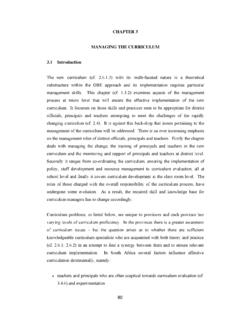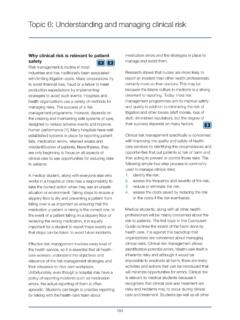Transcription of MANAGING CDBG: A Guidebook for Grantees on …
1 Department of Housing and Urban Development Office of Community Planning and Development Community Development Block Grant Program MANAGING CDBG. A Guidebook for Grantees on Subrecipient Oversight March 2005. HUD-2005-03-CPD 2. MANAGING CDBG: A Guidebook FOR ENTITLEMENT Grantees . ON SUBRECIPIENT OVERSIGHT. Department of Housing and Urban Development Office of Community Planning and Development Community Development Block Grant Program Updated Reprint March 2005. 3. MANAGING CDBG. A Guidebook for CDBG Grantees on Subrecipient Oversight introduction . TABLE OF CONTENTS. vi CHAPTER 1: introduction . WHAT IS THIS Guidebook ABOUT? ..1-2. KEY MANAGEMENT CONCEPTS ..1-4. WHO ARE CDBG SUBRECIPIENTS? ..1-5. HOW DO SUBRECIPIENTS DIFFER FROM THE GRANTEE'S EMPLOYEES? ..1-6. HOW DO SUBRECIPIENTS DIFFER FROM CONTRACTORS? ..1-7. WHAT TYPES OF ACTIVITIES DO SUBRECIPIENTS CARRY OUT?..1-8. CONTINUING GRANTEE RESPONSIBILITY ..1-8.
2 TYPES OF MONITORING ISSUES ..1-9. HOW IS THIS Guidebook ORGANIZED? ..1-9. USING THIS Guidebook ..1-10. CHAPTER 1: APPENDIX. Summary of National Objectives ..1-14. Statement of Eligible and Ineligible Activities ..1-22. CHAPTER 2: PRE-AWARD ASSESSMENT. FACTORS IN A PRE-AWARD ASSESSMENT ..2-3. MODELS FOR PERFORMING PRE-AWARD ASSESSMENTS AND. SELECTING SUBRECIPIENTS ..2-6. A MIXTURE OF DEALING WITH A SCARCITY OF QUALIFIED ORGANIZATIONS ..2-11. CHAPTER 2: APPENDIX. Sample Subrecipient Application Package ..2-14. Basic Elements of a Subrecipient Application for Funding and Applicable Federal Regulations ..2-23. Subrecipient Selection Application Rating Risk Analysis CHAPTER 3: SUBRECIPIENT AGREEMENTS. MINIMUM HUD REQUIREMENTS ..3-3. iv MANAGING CDBG. A Guidebook for CDBG Grantees on Subrecipient Oversight introduction . WRITTEN AGREEMENT AS A MANAGEMENT WRITTEN AGREEMENT AS A TRAINING TOOL ..3-6. COMMON PROBLEMS WITH SUBRECIPIENT SUMMARY.
3 3-8. CHAPTER 3: APPENDIX. Subrecipient Agreement Citations for the Basic Elements of a Subrecipient Agreement ..3-13. Other Program Requirements ..3-14. Sample Subrecipient Agreement ..3-15. Sample Scopes of Service Public Service Activities ..3-34. Housing Rehabilitation Activities ..3-37. Special Economic Development Job Creation Activities ..3-43. CHAPTER 4: ORIENTATION, TRAINING, AND TECHNICAL ASSISTANCE. ORIENTATION SESSIONS ..4-3. TRAINING SESSIONS ..4-6. TRAINING DESIGN CRITERIA ..4-8. TECHNICAL ASSISTANCE ..4-9. MEASURING SUBRECIPIENT CHAPTER 4: APPENDIX. Sample Training curriculum on Relocation, Real Property Acquisition, and One-for-One Housing Replacement in CDBG Sample Handout: Summary of Major Differences Between 104(d) and URA. Relocation Assistance ..4-20. Sample List of Written Materials ..4-22. CHAPTER 5: MONITORING STRATEGIES AND PROCEDURES. THE MONITORING PROCESS ..5-4. PREPARATION FOR THE MONITORING CONDUCTING THE MONITORING ADDITIONAL SOURCES OF EVALUATION INFORMATION.
4 5-11. SUMMARY ..5-12. CHAPTER 5: APPENDIX. Summary of Monitoring v MANAGING CDBG. A Guidebook for CDBG Grantees on Subrecipient Oversight introduction . HUD Monitoring Review of Grantee Oversight of Subrecipients ..5-16. Checklist for On-site Monitoring of a Outline for a Subrecipient Monitoring Workbook ..5-25. Example of a Grantee Monitoring Letter to a Subrecipient ..5-33. Review of IPA Audit Reports ..5-37. CHAPTER 6: SYSTEMS AND PROCEDURES FOR TRACKING. SUBRECIPIENT PROGRESS. introduction - RATIONALE AND BENEFITS. OF EFFECTIVE TRACKING ..6-2. SIX KEY ELEMENTS OF INFORMATION SYSTEMS: PRINCIPLES AND PRIORITIES ..6-3. INFORMATION FOR PERFORMANCE THREE LEVELS OF PROGRAM TRACKING Level 1: Periodic Reporting for Individual Level 2: Accumulating Data About Groups of Level 3: Integrated Financial and Program Management DEALING WITH COMMON PROBLEMS ..6-17. SUMMARY ..6-20. CHAPTER 6: APPENDIX. Overview: Purpose of Tracking Information.
5 6-23. Documentation to be Maintained ..6-24. Consolidated Annual Performance and Evaluation Report Sample Monthly Report and Voucher Document ..6-31. CHAPTER 7: FOLLOW-UP PROCEDURES. introduction ..7-2. BASIC FOLLOW-UP PRINCIPLES ..7-3. FOLLOW-UP IN A CHANGING REGULATORY ENVIRONMENT ..7-4. THE INFLUENCE OF REWARDING SUPERIOR OR IMPROVED LEARNING FROM THE PRINCIPLE OF PROGRESSIVE SANCTIONS ..7-8. Stage I: Early Warning/Early Stage II: Intervention for More Serious or Persistent Problems ..7-10. Stage III: Red Alert ..7-11. vi MANAGING CDBG. A Guidebook for CDBG Grantees on Subrecipient Oversight introduction . CHAPTER 7: APPENDIX. Common Subrecipient Monitoring Problems Program Income ..7-16. Economic Development ..7-19. CHAPTER 8: HUD'S OFFICE OF THE INSPECTOR GENERAL. introduction : WHY SHOULD YOU READ THIS CHAPTER? ..8-2. WHAT ARE THE POWERS OF THE HUD INSPECTOR GENERAL? ..8-3. WHAT PROCEDURE MUST THE OIG FOLLOW IN.
6 CONDUCTING AN AUDIT? ..8-5. WHAT GENERAL AUDITING STANDARDS MUST THE OIG FOLLOW? ..8-7. SPECIFIC STANDARDS FOR FIELD WORK AND REPORTING ..8-8. WHAT IS THE PROCESS FOR RESOLVING AUDIT FINDINGS? ..8-9. TYPICAL SCHEDULE FOR RESOLUTION ..8-10. SUMMARY ..8-11. CHAPTER 8: APPENDIX. Audit Response Checklist ..8-14. vii MANAGING CDBG. A Guidebook for CDBG Grantees on Subrecipient Oversight introduction . BACKGROUND. Not long after the Community Development Block Grant (CDBG) program, administered by the Department of Housing and Urban Development (HUD), got underway in 1975, Grantees began using independent governmental agencies and non-profit organizations to carry out certain activities. The enabling legislation authorized the use of such entities because of their involvement in a number of the programs that preceded CDBG, most notably the Model Cities and Urban Renewal/NDP programs. Initially, non-profits were employed as CDBG subrecipients by only a few Grantees , primarily to undertake residential rehabilitation and some public services in deteriorated neighborhoods.
7 As the program and the Grantees matured, and as non-profits proliferated, Grantees began using subrecipients more frequently and for a wider range of activities, including economic development. The growing involvement of subrecipients brought with it a number of problems. HUD monitors often found that Grantees were unaware of what their subrecipients were using CDBG funds for and subrecipients could not produce documentation showing how Federal rules were being met. By the end of the 1980's, HUD's Inspector General declared that the lack of proper management of subrecipients in the CDBG program constituted a material weakness. HUD knew that it had to find tools to enable its Grantees to deal with this growing problem. In response to this concern, this Guidebook and its companion materials, Playing by the Rules: A. Handbook for CDBG Subrecipients on Administrative Systems and Training CDBG Subrecipients in Administrative Systems, were originally published in August of 1993 and made available to entitlement cities and urban counties participating in the CDBG program.
8 Shortly following publication, the Guidebooks were also used as the centerpiece for training entitlement communities in the proper management of subrecipients. Since their publication in 1993, there have been a number of significant changes in CDBG program rules and policies. Some of the most notable include: the transformation of the CDBG Final Statement into the Consolidated Plan and the Grantee Performance Report into the Consolidated Annual Performance and Evaluation Report (CAPER); the introduction of Community-Based Development Organizations (CBDOs) to replace what had been referred to in the CDBG program as special subrecipients ; revisions to the requirements for handling CDBG program income (especially interest earned on a revolving fund ); the addition of several new eligible uses of CDBG funds ( , homeownership assistance and microenterprise assistance); a substantial number of changes in the requirements concerning the use of CDBG funds for special economic development activities; and the incorporation of OMB Circulars A-102 and A-110 into the HUD.
9 Common Rule at 24 Code of Federal Regulations (CFR) Parts 84 and 85. These changes have been integrated into the updated editions of all three publications being issued. The fundamental advice provided in the Guidebooks as they were originally published focused on MANAGING subrecipients in the CDBG Entitlement program and that function remains unchanged in this update. All three publications are available on the HUD. Web site at Experience has shown that activities undertaken by subrecipients are still potentially high risk. Many subrecipients have excellent intentions, but use volunteers or inexperienced staff who don't know Federal requirements. In our efforts to promote timely expenditure of CDBG funds, we found that delays in subrecipient activities were also a cause for grantee failure to comply with the timeliness requirements at 24. CFR Over ten years have passed since CPD first issued these three publications dealing with subrecipients.
10 This material is now being updated because of the changes in program requirements mentioned above, as well as the fact that Grantees and subrecipients have experienced staff turnover, and new subrecipients are participating in the program. Therefore, it is again time to focus grantee attention on their responsibilities for viii MANAGING CDBG. A Guidebook for CDBG Grantees on Subrecipient Oversight introduction . subrecipient oversight and to encourage Grantees to take a fresh look at their internal processes for subrecipient selection, training, management, reporting, and monitoring. Since these publications are on the HUD Web site, Grantees will find it easier to distribute materials and to conduct training for their subrecipients. Furthermore, the sound management practices advocated in the Guidebooks will also serve to assist both Grantees in developing performance management systems and subrecipients in meeting the performance measures for project implementation.

















